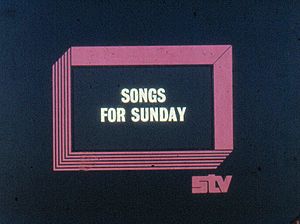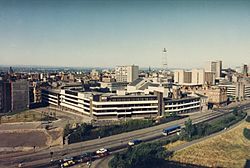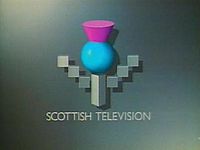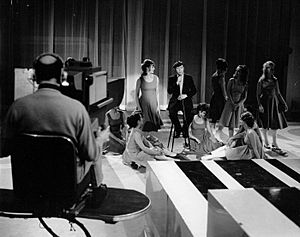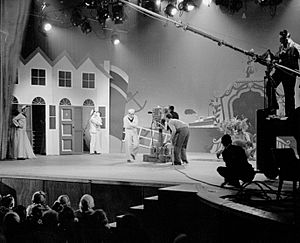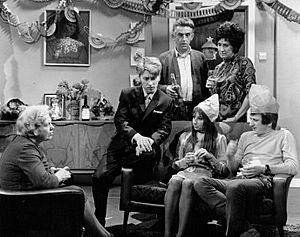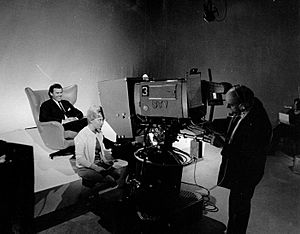Scottish Television facts for kids
 |
|
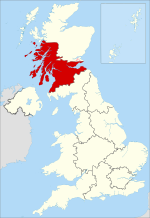 |
|
| Type | Region of television network |
|---|---|
| Branding | STV |
| Country | United Kingdom |
| First air date | 31 August 1957 |
| Headquarters | Glasgow |
| Broadcast area | Central Scotland |
| Owner | STV Group |
| Dissolved | lost on-air identity on 2 March 2006 (now known as STV at all times) |
| Former names | Scottish Television (1957–2006) |
| Picture format | 1080i HDTV, downscaled to 16:9 576i for SDTV |
| Affiliation | ITV |
| Language | English |
| Replaced by | STV Central |
Scottish Television is a major TV channel in Central Scotland. It is now officially called STV Central Limited. This channel is part of the ITV network. It is the biggest of the three ITV channels in Scotland.
STV Central started broadcasting on August 31, 1957. This makes it the second-oldest active TV channel in the UK. The oldest is Granada Television.
STV Central broadcasts from studios in Pacific Quay in Glasgow. It is owned by STV Group, which used to be called SMG plc. This group also owns the TV channel for Northern Scotland, Grampian Television (now called STV North). STV North is based in Aberdeen.
STV Central creates news shows for its region, like STV News at Six. It also makes current affairs and special programs for both Northern and Central Scotland. Along with STV North and ITV Border, STV Central is a private company that competes with the public broadcaster, BBC Scotland.
Contents
The Story of STV: How it Began and Grew
Scottish Television was started by a Canadian newspaper owner named Roy Thomson. He later became Lord Thomson. To set up the TV station, he bought the Theatre Royal, Glasgow building. He invited a Canadian TV producer, Rai Purdy, to be the first head of programming. Purdy promised that the new channel would offer "first class entertainment" and lots of cultural shows. He also wanted to help "Scottish talent" get seen on STV.
Getting Ready to Launch
In May 1955, Roy Thomson was told he would get the contract for a Scottish TV company. The plan was for the TV station to be ready by August 1957. Thomson signed the contract in June 1957.
Starting a new TV channel meant people needed to change their TV sets or aerials. Older TVs needed a special device, and even newer ones needed an extra aerial. This was a huge job, as there were almost half a million TVs in Scotland. To avoid problems, STV held 21 exhibitions in towns across the area.
These exhibitions showed people what the new channel would be like. Visitors got a free guide to the programs. They could see both BBC shows and the new commercial programs. STV even had a special vehicle with TV equipment worth over £10,000. A cinema show at the exhibition showed clips of upcoming STV shows. These included American shows like I Love Lucy and British ones like Sunday Night at the Palladium. They also showed local videos, hoping people would see themselves on TV!
Thomson first said they would make about ten hours of Scottish programs each week. This was when they were limited to 50 hours of total programming per week. However, the final plan was for only 15% of programs to be from Scotland. This was a bit less than the 20% promised earlier.
They planned a talent show called Fanfare, a quiz show, and a play once a month. They also planned a series called The Tamsons about a Scottish family. A children's program called Scotsplay was also in the works. In Heaven and Earth was meant to be a "big cultural effort." It would cover "anything and everything culturally interesting." British news would be shown twice a day, followed by Scottish news. In July, it was announced that Scottish actor James Robertson Justice would introduce STV's first show, This is Scotland.
The First Years: 1950s and 1960s
Scottish Television started broadcasting at 5:30 pm on Saturday, August 31, 1957. The first show was This is Scotland. It was an hour-long live variety show from the Theatre Royal studios. STV was the seventh ITV channel to launch. It was also the first to broadcast seven days a week. STV's first sports show was "Fanfare," which started on September 2, 1957.
The company quickly became known for music, variety shows, documentaries, and Scottish sports. It also supported Scottish Opera. Much of its early content came from ATV. By 1965, ATV's senior producer, Francis Essex, became Scottish's programming controller.
However, STV also got a reputation for low-budget entertainment shows. Some joked that STV only had two machines: one for western films and one for commercials. Lord Thomson was also criticized. He used much of the money from Scottish Television to buy more newspapers.
In 1965, Charles Hill, the head of the Independent Television Authority, visited STV. He saw a show called The One O'Clock Gang. He was so shocked that he cancelled the program himself.
STV also started pioneering TV for schools with Glasgow Corporation. They also began postgraduate TV services, including surgery, with universities. Programs were made for new countries in the British Commonwealth. The Thomson Foundation was created to train TV producers and journalists.
The STV service quickly became profitable. Thomson famously said that "running a commercial television station is like having a licence to print money." In 1966, the company was listed on the London Stock Exchange.
Scottish Television kept its license in 1967. This was despite strong competition. Lord Thomson had to reduce his ownership in the station from 80% to 25%. This meant the company was no longer mainly owned by the Thomson Group.
Colour TV started at the end of the 1960s. New studios opened at the Gateway Theatre in Edinburgh in October 1969. The next month, on November 3, the Theatre Royal headquarters were badly damaged by a fire. A firefighter died in the fire.
Challenges and Growth: The 1970s
Like many ITV channels, Scottish Television faced difficulties in the late 1960s and early 1970s. There was a recession, higher fees for transmitters, and less money from advertising. The cost of upgrading equipment for colour TV also added to the problems. In 1970, the company lost £39,000. There were warnings that it might have to merge with Grampian Television.
By late 1971, STV's situation improved. Changes in tax rules helped, and advertising increased. Profits rose to £475,000 in the first six months of 1971. A lot of these profits were used to make more programs. This helped address criticism about the station's output. They improved sports coverage, added new dramas, and enhanced local entertainment.
STV hoped to become a major player in creating new programs for a possible "ITV2." This was before Channel 4 was created. STV also wanted to work more with foreign TV stations. They worked with an Israeli TV company, helping them with post-production.
The company started building its new main studios in Cowcaddens in early 1972. They moved from the Theatre Royal in December 1974.
In 1975, a short strike affected the ITV network. STV's staff refused to return to work after a lockout. Normal service resumed on June 9. By 1978, company profits had increased by 21.8%. This allowed for more local programming.
Modernizing and Expanding: The 1980s and 1990s
In the 1970s and 1980s, Scottish Television made many religious programs. These included church services, Sunday religious shows, and the popular Late Call. They also made documentaries. However, these religious programs were gradually stopped in the 1990s.
In October 1981, Scottish Television was the first ITV station to offer a regional Oracle teletext service. It had over 60 pages of local news, sports, and information.
In the past, STV programs were either made entirely in the studio or included film clips. News programs like Scotland Today and Take the High Road used film inserts. Other shows like documentaries and dramas were shot entirely on film. STV had up to six film crews. They covered daily news, football matches, and feature programs.
Using film for news caused delays. STV sent its film to a special company for processing. The film had to reach the labs by 4:30 pm to be included in Scotland Today. By the mid-1980s, STV switched to electronic news gathering. They used Sony's Betacam system.
Gus Macdonald became the station's Director of Programmes in 1986. He changed the regional news and features. Scotland Today became a hard news program again. Longer-running shows like What's Your Problem? were cancelled. New shows included Live at One Thirty and Scottish Action.
Throughout the 1980s, STV gained more access to the national network. This was mainly through the soap opera Take the High Road and the detective series Taggart. They also made programs for Channel 4. Later in the decade, game shows like Wheel of Fortune and Fun House started long runs on the ITV network.
In 1990, Sir William Brown retired as managing director after 24 years. Gus Macdonald took over. He reduced the workforce from 800 to 330 people.
In 1992, J. Nigel Pickard joined STV. He brought some children's programs from his old company, TVS. These included Art Attack and How 2. Scottish Television continued to be a major producer of children's programming throughout the 1990s.
STV kept its license in 1991 without competition. Its production part became a separate company, Scottish Television Enterprises. The company bought shares in other TV and media firms. This included a 25% share in GMTV. This helped profits rise to £10 million. In 1994, the Mirror Group bought a 20% share in STV. In 1995, STV bought a 20% share in HTV.
In 1996, the HTV shares were sold. STV bought Caledonian Publishing, which published The Herald and the Glasgow Evening Times. In 1997, Scottish Media Group plc bought Grampian Television for £105 million. Soon after, the company became SMG.
In April 1998, Scottish TV partnered with Canadian company Nelvana and American network CBS. They produced six new animated series. Scottish TV had a big role in creating these shows. The new shows included Franklin, Anatole, and Mythic Warriors: Guardians of the Legend. In November, Scottish TV doubled its funding for children's programming.
In 1999, Gus Macdonald left the company to become a Scottish Trade Minister. The Mirror Group sold its share to Granada.
The 2000s: Becoming STV
On March 2, 2006, SMG plc (now 'STV Group plc') announced a big change. Scottish Television would go back to being called 'STV'. This name was used from 1969 until 1985. Grampian Television would also become STV North. The new branding launched on May 30, 2006.
In January 2007, the station started separate news services. These were for the East and West parts of the STV Central region. They began as a five-minute part of the 6:00 pm Scotland Today show on weekdays.
Where STV is Made: Studios and Locations
From 1957 to 1974, Scottish Television used the Theatre Royal, Glasgow as its main studio. In 1969, new studios were built at the Gateway Theatre in Edinburgh. These became more important after a fire at the Theatre Royal in November 1969.
In 1974, Scottish TV moved its main base to new, specially built facilities in Cowcaddens, Glasgow. This new building was officially opened on December 12, 1974. It was expanded in 1978. After the move, the Theatre Royal was sold to Scottish Opera.
Cowcaddens became STV's main studio. However, as more programs were made by independent companies, less studio space was needed. New Scottish programs like Art Attack were made elsewhere. To save money, the Gateway Theatre studios in Edinburgh closed in 1994.
In 2006, STV moved from Cowcaddens to a new, smaller building at Pacific Quay. This new location is next to the headquarters of BBC Scotland. The old Cowcaddens site was torn down in 2007. STV's Edinburgh operations are now in smaller studios in Fountainbridge.
How STV Looks and Sounds: Presentation
Scottish Television's first on-air symbol was the Lion Rampant of Scotland. This was first a still picture. By 1965, an animated version showed the lion spinning. The station's first theme music was "Scotlandia" by Geraldo. This music played at the start of each day's broadcasting until 1985.
After colour TV started, the lion symbol was replaced. A new, stylish 'STV' logo was used. This logo would form on screen with a trumpet sound. Throughout the 1970s and until 1985, this STV logo was used. It often appeared against a blue background with a tartan-like pattern.
On August 31, 1985, the station brought back the 'Scottish Television' name. It introduced a new computer-made thistle symbol. Special versions of the symbol were made for events like the station's 30th anniversary in 1987. The thistle logo was updated in 1989 and used until 2000.
Scottish Television used to have announcers appear on screen. They would introduce programs and give short news updates. This was reduced in 1988 when 24-hour broadcasting started. It was stopped completely in 1991.
Scottish TV did not use the ITV network's general look in 1999. Instead, it launched a new logo with Grampian Television in 2000. This logo featured a blue square with the words 'Scottish TV'. New videos were made showing Scottish people and places. This look was used until 2003. Then, Scottish and Grampian adopted the celebrity idents package.
The celebrity look was used until 2006. Then, the Scottish and Grampian names were replaced by one unified 'STV' look. The first STV ident showed a long blue 'S' being passed between people in different Scottish scenes. An updated look was introduced in 2009. It showed a picture postcard scene flipping over to reveal another theme.
On June 2, 2014, STV's logo was updated again. The white "tv" is now on a blue triangle. Three light blue curves appear on the sides. The "S" changed to light blue colours.
STV Shows: A Look at What They Made
STV has made many different types of programs over the years. All programs are now made under the name STV Studios.
News and Current Affairs
- Scotland Today (1972–2009)
- STV News at Six (2009–present)
- Politics Now (2004–2011)
- Seven Days (1998–2004)
Sports Programs
- Champions League Live (1992–2015)
- Scotsport (1957–2008)
Documentaries and Features
- The Bowler and the Bunnet (1967)
- Club Reps (2001–2004)
- Moviejuice (2000–present)
- The Nightshift (2010–2015)
- Scottish Passport (1993–2004; 2012–present)
- Weir's Way (1976–1987)
Entertainment Shows
- The Adventures of Francie and Josie (1962–1965)
- The Andy Stewart Show (1970s)
- Now You See It (1981–1986)
- The One O'Clock Gang (1958 – 1964)
- Postcode Challenge (2007–2011)
- Wheel of Fortune (1988–2001)
- Win, Lose or Draw (1990–1998)
Drama Series
- The Advocates (1991–1992)
- The Campbells (1986–1990)
- Doctor Finlay (1993–1996)
- High Living (1968–1971)
- High Times (2004, 2008)
- Garnock Way (1976–1979)
- McCallum (1995–1998)
- Rebus (2000–2007)
- The Steamie (1988)
- Taggart (1983–2010)
- Take the High Road (1980–2003)
Children's and Animated Shows
- Art Attack (1993–2007)
- Anatole (co-produced with Nelvana and CBS)
- Birdz (co-produced with Nelvana and CBS)
- The Disney Club (1989–1998)
- Fun House (1989–1999)
- Glen Michael's Cartoon Cavalcade (1966–1992)
- How 2 (1990–2006)
- Hurricanes (1993–1997)
- Mythic Warriors: Guardians of the Legend (co-produced with Nelvana and CBS)
- Rupert (co-produced with Nelvana, 1992–1997)
- Sherlock Holmes in the 22nd Century (1999-2001)
- What's Up Doc (1993–1995)
Religious Programs
- Late Call
- Morning Worship (contribution to the ITV network)
Scots Gaelic Programs
- Machair (Drama)
- Speaking our Language (Learners)



